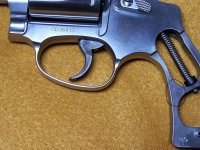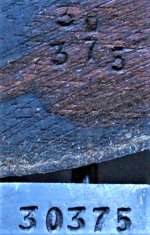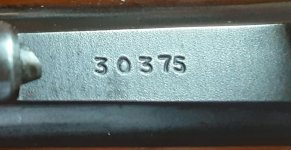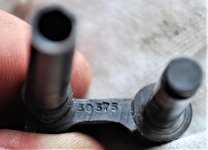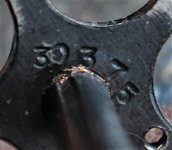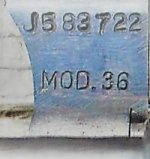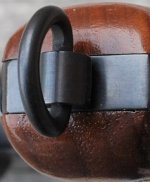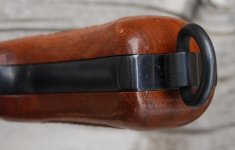You are using an out of date browser. It may not display this or other websites correctly.
You should upgrade or use an alternative browser.
You should upgrade or use an alternative browser.
serial number locations
- Thread starter MHF
- Start date
Yes and no…
I can’t answer your question about specific models, but there was a short time when S&W didn’t place the serial numbers on the butt. They put them on the left side of the frame and on the left side of the grip frame, under the grips of this model 60-10.


I can’t answer your question about specific models, but there was a short time when S&W didn’t place the serial numbers on the butt. They put them on the left side of the frame and on the left side of the grip frame, under the grips of this model 60-10.
Attachments
Last edited:
- Joined
- Jun 28, 2007
- Messages
- 27,660
- Reaction score
- 21,269
As a rule, S & W would put a serial number somewhere besides on the bottom of the grip frame if the gun had (or was likely to have) Target stocks covering the usual area. This dates back to the .22/32 Heavy Frame Target and Regulation Police models of the early 20th century.
As it probably had Uncle Mike's rubber grips originally, Chad's example of the 60-10 follows this. One non-factory exception at about the same time were the NY-1 DAO model 64 .38 Specials; even though they probably shipped with Magna service stocks, so many of these had oversized rubber grips put on after production the factory moved the SN to the left frame.
As for your guns, help us out and let us know where the SNs are . Of your examples, I believe the 638-3 probably had oversized rubber stocks so you will probably find the SN in the yoke cutout, under the barrel.
. Of your examples, I believe the 638-3 probably had oversized rubber stocks so you will probably find the SN in the yoke cutout, under the barrel.
As it probably had Uncle Mike's rubber grips originally, Chad's example of the 60-10 follows this. One non-factory exception at about the same time were the NY-1 DAO model 64 .38 Specials; even though they probably shipped with Magna service stocks, so many of these had oversized rubber grips put on after production the factory moved the SN to the left frame.
As for your guns, help us out and let us know where the SNs are
Last edited:
Have a Model 37 no dash that shipped in 1982. I only see the SN on the butt. What age are your guns?
Alk8944
US Veteran
All S&Ws have the SN stamped on the bottom of the grip frame ALWAYS. This is the LEGAL SN! If it does not appear in this location on a gun it is because someone has illegally removed it and the gun is contraband and illegal to possess. There are several additional locations the SN may also appear, but the one on the butt must be there. There is only one exception to this that I am aware of, the older Regulation Police model, where the SN was applied to the front of the grip frame instead of the butt If the original SN and ownership can be proven you can petition the ATF to issue a new ATF SN and they will mark the gun with that number that then becomes the legal SN for the gun. The gun must be surrendered to the ATF for this process and they may either assign a number or seize and destroy the gun!
In addition, depending on model and period of manufacture the SN may be found on any of the following locations, but they are not the legal SN:
Bottom flat of the barrel
On the rear face of the cylinder
Bottom left side of the frame, parallel to the butt
Left side of the frame under the cylinder window
Rear side (toward cylinder) of the yoke arm
Rear (toward the cylinder) of the extractor
In the yoke cut of the frame by the model number (if it exists)
Inside the extractor rod shroud if so equipped
On the inside (toward cylinder) of the top strap (I believe)
Inside the right grip panel w/o the prefix letter
(I think that is all of them)
For some reason (Human error) any of the additional numbers may not match the legal SN exactly, usually only off by one digit, transposed numbers or, sometimes, a missing digit.
In addition, depending on model and period of manufacture the SN may be found on any of the following locations, but they are not the legal SN:
Bottom flat of the barrel
On the rear face of the cylinder
Bottom left side of the frame, parallel to the butt
Left side of the frame under the cylinder window
Rear side (toward cylinder) of the yoke arm
Rear (toward the cylinder) of the extractor
In the yoke cut of the frame by the model number (if it exists)
Inside the extractor rod shroud if so equipped
On the inside (toward cylinder) of the top strap (I believe)
Inside the right grip panel w/o the prefix letter
(I think that is all of them)
For some reason (Human error) any of the additional numbers may not match the legal SN exactly, usually only off by one digit, transposed numbers or, sometimes, a missing digit.
Last edited:
I've got several J frames and I was wondering is the butt the only serial number location? 49, 38, 638-3, 36, 37
It would help my response if you answered this question: "Why?"
All S&Ws have the SN stamped on the bottom of the grip frame ALWAYS.
Far be it for a Colt guy to question anything posted here, but s&wchad has posted a picture of a Smith & Wesson revolver without a serial number on the butt. I have a 8.375-inch Model 617-4 Smith & Wesson revolver with the "side" serial number that does not have a serial number on the butt.
Are these exceptions to the rule, like the couple murphydog mentions?
Well, the original question, as it applies to this forum (1896 - 1961) is different than most of the responders have replied.
My example from 1953 shows the J-frame serial number locations for a Chiefs Special from that year and through about 1956.
Bottom of grip frame and inside the right grip, back of cylinder, bottom of barrel, back side of yoke, and back side of extractor star.
S&W began eliminating the s/n's on the back of the cylinder, the back of the yoke, and the bottom of the barrel in about '56 or '57.
The s/n on the back of the inside of the right grip and the extractor star was eliminated in about 1980, or so.
Now, then, as to Alk8944's comment that the serial number was "ALWAYS" on the bottom of the J-frame grip frame, well, not true... see my next post.
My example from 1953 shows the J-frame serial number locations for a Chiefs Special from that year and through about 1956.
Bottom of grip frame and inside the right grip, back of cylinder, bottom of barrel, back side of yoke, and back side of extractor star.
S&W began eliminating the s/n's on the back of the cylinder, the back of the yoke, and the bottom of the barrel in about '56 or '57.
The s/n on the back of the inside of the right grip and the extractor star was eliminated in about 1980, or so.
Now, then, as to Alk8944's comment that the serial number was "ALWAYS" on the bottom of the J-frame grip frame, well, not true... see my next post.
Attachments
Last edited:
In 1977 S&W filled an order for 2,000 round butt Chiefs Special Model 36 for the Navy.
The Navy requirement had a lanyard on the butt. The serial number could not fit on the butt so it was stamped on the frame inside the yoke cut. My example is one of the 112 Navy contract overruns S&W sold on the civilian market after filling the Navy order.
The Navy requirement had a lanyard on the butt. The serial number could not fit on the butt so it was stamped on the frame inside the yoke cut. My example is one of the 112 Navy contract overruns S&W sold on the civilian market after filling the Navy order.
Attachments
Last edited:
In the late ‘90’s, S&W started laser etching serial numbers on some revolver. These markings were extremely shallow and could be buffed off rather easily, so they placed them on various locations on the frame, but not on the butt. Mine is one of these and I’m confident yours is too. The ATF subsequently came up with a ruling that the markings had to be .003” deep, so S&W discontinued the practice. It’s mentioned in the SCSW.Far be it for a Colt guy to question anything posted here, but s&wchad has posted a picture of a Smith & Wesson revolver without a serial number on the butt. I have a 8.375-inch Model 617-4 Smith & Wesson revolver with the "side" serial number that does not have a serial number on the butt.
Are these exceptions to the rule, like the couple murphydog mentions?
Last edited:
"Well, the original question, as it applies to this forum (1896 - 1961) is different than most of the responders have replied."
Duly noted most of my J frames are from post 61, so I should have posted my question to the next forum. As to "Why" because I didn't want to pull my laser grips.
Duly noted most of my J frames are from post 61, so I should have posted my question to the next forum. As to "Why" because I didn't want to pull my laser grips.
"Well, the original question, as it applies to this forum (1896 - 1961) is different than most of the responders have replied."
Duly noted most of my J frames are from post 61, so I should have posted my question to the next forum. As to "Why" because I didn't want to pull my laser grips.
That’s fair enough. The answer, then, for the most part, is yes. The 638-3 is outside the scope of this forum, so it might be on the frame next to the Model # . . .
Lots of good information posted above. I'm late to the party but this summary with approximate time frames might be helpful:
(Note: Almost any statements about S&W's protocol, stampings, location and meaning of stampings, etc., are presumed to be trends and should not be taken as rules. The main reason is that things changed over time, weren’t always consistent, and transition periods always exist. Hand Ejectors have been around for over 125 years.)
SERIAL # LOCATIONS
We owe the Russians a vote of thanks; having been the 1st to require multi-serial # locations on their S&W #3 contract revolvers.
Here are the 6 or 7 (Triple Lock models only) pre war fixed sight frame serial # locations which are also the locations remaining after WW II thru ~1956 to look for (not including the 3 stamped serial # locations for pre war and early post war Transitional models with pre war target sights.)
NOTE: Always use optical magnification including a flashlight when looking at or for serial numbers to observe the information accurately.
Observing a serial # for accuracy or even existence, especially on penciled stocks, requires an attitude that it is there!
1. Grip frame butt* (prefixed by a letter(s) following WWII) - or forestrap* on I frames/single shots with grips that cover the butt
2. Barrel - bottom of barrel or in extractor shroud
3. Yoke - on rear face (except the .32 Model 1896) only visible thru a chamber with a flashlight
4. Extractor star – backside (which is actually the side facing the muzzle).
5. Cylinder - rear face
6. Right stock only - on back, scratched or penciled depending on vintage and stock material, stamped after 1929, (except most post war target grips because individual fitting not required.)
7. Mid-lock cam plate, backside with cyl open – “Triple Locks” only, in any caliber (up to all 5 digits).
*NOTE: The one location with few exceptions that you can be sure of reading the original serial number for all Hand Ejectors of any vintage with stamped numbers, (which includes any letter(s) prefixed #s after WW II,) is the BUTT of the gun, (or front grip strap on non-round stocked .22/32 Kit guns and Targets, .32 & .38 S&W Regulation Police pre Model of 1953 I frames, the .32 Transitional Targets from 1957, and single shots).
DECREASING SERIAL # LOCATIONS
The number of serial # locations or if a Model/dash # is stamped on a particular S&W Hand Ejector has more to do with where it was in the production/assembly stages then when change orders were issued, therefore as we've learned to expect with S&W, there are great variances and exceptions galore.
Officially, on May 1, 1957 S&W eliminated the Soft Fitting Operation: So it generally corresponds with the model number stamping order June 12, 1957. It was no longer necessary to routinely stamp the serial number on the barrel, cylinder & yoke arm rear surface and serial #s show or not over a transition period. So guns in process or in inventory as of 5/1/57 can still have more than 3 and up to 6 locations, and guns shipped after this time may have some of the former number locations because assembly was done over time and as inventory from the old process was used up.
The 6 serial # locations were down to only 3 left on the majority of models (but not all) from c. late 1957 to 1959 which are:
1. Grip frame butt (prefixed by a letter(s) following WWII)
2. Extractor star - backside
3. Right stock – backside (except most post war target grips because individual fitting not required.)
YOKE CUT STAMPING of the assembly (work) # vs. serial #
changes after Model # stamping got more confusing. When Model Number stamping began some months to a year after being ordered June 12, 1957, the serial number was not yet stamped in the frame ‘yoke cut’ on the frame side of the yoke hinge. But in the l958-1959 time period as the use of target grips became more common and if the revolver was ordered with or was standard with target stocks which covered the butt serial #, the serial number is stamped in the yoke cut of the frame. The assembly number would have also been in this area, as it was stamped on the gun long before the revolver was serial numbered.
But when the serial # was stamped on the frame in the 'yoke cut', except on the smaller frames at first where it just didn't fit well, the frame assembly # from the 'yoke cut' was moved to the left side of the grip frame. The 3 assembly # locations became the yoke, left side of grip frame (later the right side), and backside of side plate. However, the post 1959-60 yoke cut serial # placement on the later guns is the reason for many pre 1957 guns to be incorrectly registered by the useless assembly # on the frame in the yoke cut.
Therefore by about the end of 1959, serial # locations went up to 4:
1. Grip frame butt (prefixed by a letter(s) following WWII)
2. Frame in yoke cut
3. Extractor star until ~ 1980 when the new extractor star shape was introduced.
4. Back of right stock, until ~ 1979 when no longer hand fitted, (except most post war target grips because individual fitting not required).
EXTRACTOR STAR Serial #
Once the new shaped extractor star is introduced apparently beginning c. early 1980’s, and completed on all models by c. mid 1990s, it seems to have been coincident with deleting serial # stamping. Only the butt and yoke cut stamping locations remain to this day. But again with exceptions like anything S&W, as we some later introductions with laser engraved serial #s in new locations.
STOCK #s:
stamped since 1857, changed to penciled #s c. 1900 and back to stamped #s in 1929. Post War c. 1960 #s changed from vertically high up on grip, to low and parallel to butt (sometimes 2 lines). The stock # and hand fitting were dropped c. mid to late 1970s due to a more accurate stock making technique. Premium stocks may just have a letter stamp indicating frame size, i.e., ‘I’ for I frame, etc.
Therefore today the norm is only two serial # stamped locations on most revolvers:
1. Grip frame butt
2. Frame in yoke cut
LASER ENGRAVED SERIAL NUMBERS
once introduced in the late 1980s, the last two locations continue on the bottom of the butt and in the yoke cut. But there are exceptions, like below the cylinder, left side of frame below the cyl window and may or may not be on the butt.
(Note: Almost any statements about S&W's protocol, stampings, location and meaning of stampings, etc., are presumed to be trends and should not be taken as rules. The main reason is that things changed over time, weren’t always consistent, and transition periods always exist. Hand Ejectors have been around for over 125 years.)
SERIAL # LOCATIONS
We owe the Russians a vote of thanks; having been the 1st to require multi-serial # locations on their S&W #3 contract revolvers.
Here are the 6 or 7 (Triple Lock models only) pre war fixed sight frame serial # locations which are also the locations remaining after WW II thru ~1956 to look for (not including the 3 stamped serial # locations for pre war and early post war Transitional models with pre war target sights.)
NOTE: Always use optical magnification including a flashlight when looking at or for serial numbers to observe the information accurately.
Observing a serial # for accuracy or even existence, especially on penciled stocks, requires an attitude that it is there!
1. Grip frame butt* (prefixed by a letter(s) following WWII) - or forestrap* on I frames/single shots with grips that cover the butt
2. Barrel - bottom of barrel or in extractor shroud
3. Yoke - on rear face (except the .32 Model 1896) only visible thru a chamber with a flashlight
4. Extractor star – backside (which is actually the side facing the muzzle).
5. Cylinder - rear face
6. Right stock only - on back, scratched or penciled depending on vintage and stock material, stamped after 1929, (except most post war target grips because individual fitting not required.)
7. Mid-lock cam plate, backside with cyl open – “Triple Locks” only, in any caliber (up to all 5 digits).
*NOTE: The one location with few exceptions that you can be sure of reading the original serial number for all Hand Ejectors of any vintage with stamped numbers, (which includes any letter(s) prefixed #s after WW II,) is the BUTT of the gun, (or front grip strap on non-round stocked .22/32 Kit guns and Targets, .32 & .38 S&W Regulation Police pre Model of 1953 I frames, the .32 Transitional Targets from 1957, and single shots).
DECREASING SERIAL # LOCATIONS
The number of serial # locations or if a Model/dash # is stamped on a particular S&W Hand Ejector has more to do with where it was in the production/assembly stages then when change orders were issued, therefore as we've learned to expect with S&W, there are great variances and exceptions galore.
Officially, on May 1, 1957 S&W eliminated the Soft Fitting Operation: So it generally corresponds with the model number stamping order June 12, 1957. It was no longer necessary to routinely stamp the serial number on the barrel, cylinder & yoke arm rear surface and serial #s show or not over a transition period. So guns in process or in inventory as of 5/1/57 can still have more than 3 and up to 6 locations, and guns shipped after this time may have some of the former number locations because assembly was done over time and as inventory from the old process was used up.
The 6 serial # locations were down to only 3 left on the majority of models (but not all) from c. late 1957 to 1959 which are:
1. Grip frame butt (prefixed by a letter(s) following WWII)
2. Extractor star - backside
3. Right stock – backside (except most post war target grips because individual fitting not required.)
YOKE CUT STAMPING of the assembly (work) # vs. serial #
changes after Model # stamping got more confusing. When Model Number stamping began some months to a year after being ordered June 12, 1957, the serial number was not yet stamped in the frame ‘yoke cut’ on the frame side of the yoke hinge. But in the l958-1959 time period as the use of target grips became more common and if the revolver was ordered with or was standard with target stocks which covered the butt serial #, the serial number is stamped in the yoke cut of the frame. The assembly number would have also been in this area, as it was stamped on the gun long before the revolver was serial numbered.
But when the serial # was stamped on the frame in the 'yoke cut', except on the smaller frames at first where it just didn't fit well, the frame assembly # from the 'yoke cut' was moved to the left side of the grip frame. The 3 assembly # locations became the yoke, left side of grip frame (later the right side), and backside of side plate. However, the post 1959-60 yoke cut serial # placement on the later guns is the reason for many pre 1957 guns to be incorrectly registered by the useless assembly # on the frame in the yoke cut.
Therefore by about the end of 1959, serial # locations went up to 4:
1. Grip frame butt (prefixed by a letter(s) following WWII)
2. Frame in yoke cut
3. Extractor star until ~ 1980 when the new extractor star shape was introduced.
4. Back of right stock, until ~ 1979 when no longer hand fitted, (except most post war target grips because individual fitting not required).
EXTRACTOR STAR Serial #
Once the new shaped extractor star is introduced apparently beginning c. early 1980’s, and completed on all models by c. mid 1990s, it seems to have been coincident with deleting serial # stamping. Only the butt and yoke cut stamping locations remain to this day. But again with exceptions like anything S&W, as we some later introductions with laser engraved serial #s in new locations.
STOCK #s:
stamped since 1857, changed to penciled #s c. 1900 and back to stamped #s in 1929. Post War c. 1960 #s changed from vertically high up on grip, to low and parallel to butt (sometimes 2 lines). The stock # and hand fitting were dropped c. mid to late 1970s due to a more accurate stock making technique. Premium stocks may just have a letter stamp indicating frame size, i.e., ‘I’ for I frame, etc.
Therefore today the norm is only two serial # stamped locations on most revolvers:
1. Grip frame butt
2. Frame in yoke cut
LASER ENGRAVED SERIAL NUMBERS
once introduced in the late 1980s, the last two locations continue on the bottom of the butt and in the yoke cut. But there are exceptions, like below the cylinder, left side of frame below the cyl window and may or may not be on the butt.
Last edited:
Pisgah
Member
All I know is, anyone who ever says "always" or "never" with a S&W rarely knows what they're talking about ...
Similar threads
- Replies
- 22
- Views
- 711
- Replies
- 2
- Views
- 282
- Replies
- 16
- Views
- 1K
- Replies
- 13
- Views
- 558

